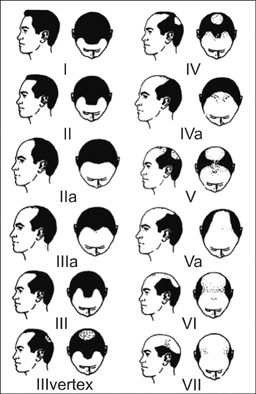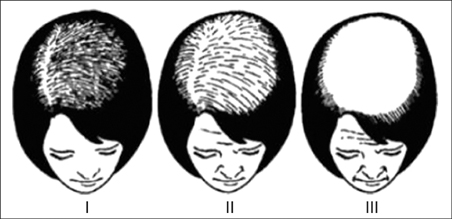Characteristics of Androgenetic Alopecia in Asian
- Affiliations
-
- 1Department of Dermatology and Institute of Hair and Cosmetic Medicine, Yonsei University Wonju College of Medicine, Wonju, Korea. leewonsoo@yonsei.ac.kr
- KMID: 2265295
- DOI: http://doi.org/10.5021/ad.2012.24.3.243
Abstract
- Androgenetic alopecia (AGA), or pattern hair loss, is a common disorder in Asian men and women, with a reported incidence of up to 73% among general population. There are several descriptions regarding the characteristics of AGA in patients of European descent. Asian patients with AGA have different types of hair loss and family histories from Europeans, which may affect treatment response. Therefore, in this review, prevalence, hair loss patterns, familial factors, androgen receptor gene polymorphisms of Asian AGA patients, and management based on algorithmic guidelines for AGA are discussed. This review may be useful for dermatologists in clinical practice for diagnosing and designing management approaches for Asian patients with AGA.
Keyword
MeSH Terms
Figure
Cited by 4 articles
-
Epigallocatechin Gallate-Mediated Alteration of the MicroRNA Expression Profile in 5α-Dihydrotestosterone-Treated Human Dermal Papilla Cells
Shanghun Shin, Karam Kim, Myung Joo Lee, Jeongju Lee, Sungjin Choi, Kyung-Suk Kim, Jung-Min Ko, Hyunjoo Han, Su Young Kim, Hae Jeong Youn, Kyu Joong Ahn, In-Sook An, Sungkwan An, Hwa Jun Cha
Ann Dermatol. 2016;28(3):327-334. doi: 10.5021/ad.2016.28.3.327.The Association between Exercise and Androgenetic Alopecia: A Survey-Based Study
Jaewoong Choi, Myungsoo Jun, Solam Lee, Sung-Soo Oh, Won-Soo Lee
Ann Dermatol. 2017;29(4):513-516. doi: 10.5021/ad.2017.29.4.513.Perception of Hair Loss and Education Increases the Treatment Willingness in Patients With Androgenetic Alopecica: A Population-Based Study
Bo-Kyung Kim, Solam Lee, Myeongsoo Jun, Hee-Chul Chung, Sung-Soo Oh, Won-Soo Lee
Ann Dermatol. 2018;30(4):402-408. doi: 10.5021/ad.2018.30.4.402.Therapeutic Efficacy of a Combination Therapy of Topical 17α-Estradiol and Topical Minoxidil on Female Pattern Hair Loss: A Noncomparative, Retrospective Evaluation
Sung Jay Choe, Solam Lee, Jaewoong Choi, Won-Soo Lee
Ann Dermatol. 2017;29(3):276-282. doi: 10.5021/ad.2017.29.3.276.
Reference
-
1. Orentreich N. Pathogenesis of alopecia. J Soc Cosmet Chemists. 1960. 11:479–499.2. Hamilton JB. Patterned loss of hair in man; types and incidence. Ann N Y Acad Sci. 1951. 53:708–728.
Article3. Norwood OT. Male pattern baldness: classification and incidence. South Med J. 1975. 68:1359–1365.
Article4. Rhodes T, Girman CJ, Savin RC, Kaufman KD, Guo S, Lilly FR, et al. Prevalence of male pattern hair loss in 18-49 year old men. Dermatol Surg. 1998. 24:1330–1332.
Article5. DeMuro-Mercon C, Rhodes T, Girman CJ, Vatten L. Male-pattern hair loss in Norwegian men: a community-based study. Dermatology. 2000. 200:219–222.
Article6. Takashima M, Iju K, Sudo M. Orfanos CE, Montagna W, Stutgen G, editors. Alopecia androgenica: its incidendce in Japanese and associated conditions. Hair research status and future aspects. 1981. Berlin: Springer-Verlag;287–293.
Article7. Kakizo K. Correlation between cancer of the stomach and alopecia. Kurume Med J. 1969. 32:1540–1565.8. Paik JH, Yoon JB, Sim WY, Kim BS, Kim NI. The prevalence and types of androgenetic alopecia in Korean men and women. Br J Dermatol. 2001. 145:95–99.
Article9. Su LH, Chen TH. Association of androgenetic alopecia with smoking and its prevalence among Asian men: a community-based survey. Arch Dermatol. 2007. 143:1401–1406.10. Xu F, Sheng YY, Mu ZL, Lou W, Zhou J, Ren YT, et al. Prevalence and types of androgenetic alopecia in Shanghai, China: a community-based study. Br J Dermatol. 2009. 160:629–632.
Article11. Tang PH, Chia HP, Cheong LL, Koh D. A community study of male androgenetic alopecia in Bishan, Singapore. Singapore Med J. 2000. 41:202–205.12. Pathomvanich D, Pongratananukul S, Thienthaworn P, Manoshai S. A random study of Asian male androgenetic alopecia in Bangkok, Thailand. Dermatol Surg. 2002. 28:804–807.
Article13. Grover S. A study of patterns of androgenetic alopecia in men: an Indian perspective. Br J Dermatol. 2005. 152:572–574.
Article14. Ellis JA, Sinclair RD. Male pattern baldness: current treatments, future prospects. Drug Discov Today. 2008. 13:791–797.
Article15. Nyholt DR, Gillespie NA, Heath AC, Martin NG. Genetic basis of male pattern baldness. J Invest Dermatol. 2003. 121:1561–1564.
Article16. Tang L, Bernardo O, Bolduc C, Lui H, Madani S, Shapiro J. The expression of insulin-like growth factor 1 in follicular dermal papillae correlates with therapeutic efficacy of finasteride in androgenetic alopecia. J Am Acad Dermatol. 2003. 49:229–233.
Article17. Choong CS, Wilson EM. Trinucleotide repeats in the human androgen receptor: a molecular basis for disease. J Mol Endocrinol. 1998. 21:235–257.
Article18. Zitzmann M, Brune M, Kornmann B, Gromoll J, von Eckardstein S, von Eckardstein A, et al. The CAG repeat polymorphism in the AR gene affects high density lipoprotein cholesterol and arterial vasoreactivity. J Clin Endocrinol Metab. 2001. 86:4867–4873.
Article19. Giovannucci E, Stampfer MJ, Krithivas K, Brown M, Dahl D, Brufsky A, et al. The CAG repeat within the androgen receptor gene and its relationship to prostate cancer. Proc Natl Acad Sci U S A. 1997. 94:3320–3323.
Article20. Panchaprateep R, Korkij W, Asawanonda P. Brain-derived nerve factor and neurotrophins in androgenetic alopecia. Br J Dermatol. 2011. 165:997–1002.
Article21. Zhuo FL, Xu W, Wang L, Wu Y, Xu ZL, Zhao JY. Androgen receptor gene polymorphisms and risk for androgenetic alopecia: a meta-analysis. Clin Exp Dermatol. 2012. 37:104–111.
Article22. Ellis JA, Stebbing M, Harrap SB. Polymorphism of the androgen receptor gene is associated with male pattern baldness. J Invest Dermatol. 2001. 116:452–455.
Article23. Sawaya ME, Shalita AR. Androgen receptor polymorphisms (CAG repeat lengths) in androgenetic alopecia, hirsutism, and acne. J Cutan Med Surg. 1998. 3:9–15.
Article24. Wakisaka N, Taira Y, Ishikawa M, Nakamizo Y, Kobayashi K, Uwabu M, et al. Effectiveness of finasteride on patients with male pattern baldness who have different androgen receptor gene polymorphism. J Investig Dermatol Symp Proc. 2005. 10:293–294.
Article25. Jung JG, Park JW, Kim MH, Cinn YW. A study on CAG repeat polymorphisms of the androgen receptor in Korean androgenetic alopecia: preliminary report. Korean J Dermatol. 2009. 47:772–776.26. Hayes VM, Severi G, Eggleton SA, Padilla EJ, Southey MC, Sutherland RL, et al. The E211 G>A androgen receptor polymorphism is associated with a decreased risk of metastatic prostate cancer and androgenetic alopecia. Cancer Epidemiol Biomarkers Prev. 2005. 14:993–996.
Article27. Hillmer AM, Flaquer A, Hanneken S, Eigelshoven S, Kortüm AK, Brockschmidt FF, et al. Genome-wide scan and fine-mapping linkage study of androgenetic alopecia reveals a locus on chromosome 3q26. Am J Hum Genet. 2008. 82:737–743.
Article28. Hillmer AM, Freudenberg J, Myles S, Herms S, Tang K, Hughes DA, et al. Recent positive selection of a human androgen receptor/ectodysplasin A2 receptor haplotype and its relationship to male pattern baldness. Hum Genet. 2009. 126:255–264.
Article29. Krupa Shankar D, Chakravarthi M, Shilpakar R. Male androgenetic alopecia: population-based study in 1,005 subjects. Int J Trichology. 2009. 1:131–133.
Article30. Sehgal VN, Kak R, Aggarwal A, Srivastava G, Rajput P. Male pattern androgenetic alopecia in an Indian context: a perspective study. J Eur Acad Dermatol Venereol. 2007. 21:473–479.
Article31. Beek CH. A study on extension and distribution of the human body-hair. Dermatologica. 1950. 101:317–331.
Article32. Kaufman KD, Olsen EA, Whiting D, Savin R, DeVillez R, Bergfeld W, et al. Finasteride in the treatment of men with androgenetic alopecia. Finasteride Male Pattern Hair Loss Study Group. J Am Acad Dermatol. 1998. 39:578–589.33. Olsen EA. Female pattern hair loss. J Am Acad Dermatol. 2001. 45:3 Suppl. S70–S80.
Article34. Olsen EA. Current and novel methods for assessing efficacy of hair growth promoters in pattern hair loss. J Am Acad Dermatol. 2003. 48:253–262.
Article35. Ludwig E. Classification of the types of androgenetic alopecia (common baldness) occurring in the female sex. Br J Dermatol. 1977. 97:247–254.
Article36. Olsen EA. The midline part: an important physical clue to the clinical diagnosis of androgenetic alopecia in women. J Am Acad Dermatol. 1999. 40:106–109.
Article37. Lee WS, Ro BI, Hong SP, Bak H, Sim WY, Kim do W, et al. A new classification of pattern hair loss that is universal for men and women: basic and specific (BASP) classification. J Am Acad Dermatol. 2007. 57:37–46.
Article38. Jung JG, Kim MH, Cinn YW. Comparison of androgenetic alopecia prevalence in paternal and maternal male family members of male androgenetic alopecia patients. Korean J Dermatol. 2006. 44:173–178.39. Goh CL. A retrospective study on the characteristics of androgenetic alopecia among Asian races in the National Skin Centre, a tertiary dermatological referral centre in Singapore. Ann Acad Med Singapore. 2002. 31:751–755.40. Lee WS, Oh Y, Ji JH, Park JK, Kim do W, Sim WY, et al. Analysis of familial factors using the basic and specific (BASP) classification in Korean patients with androgenetic alopecia. J Am Acad Dermatol. 2011. 65:40–47.
Article41. Olsen EA, Messenger AG, Shapiro J, Bergfeld WF, Hordinsky MK, Roberts JL, et al. Evaluation and treatment of male and female pattern hair loss. J Am Acad Dermatol. 2005. 52:301–311.
Article42. Cash TF. Attitudes, behaviors, and expectations of men seeking medical treatment for male pattern hair loss: results of a multinational survey. Curr Med Res Opin. 2009. 25:1811–1820.
Article43. Cash TF. The psychosocial consequences of androgenetic alopecia: a review of the research literature. Br J Dermatol. 1999. 141:398–405.
Article44. Sawaya ME, Shapiro J. Androgenetic alopecia. New approved and unapproved treatments. Dermatol Clin. 2000. 18:47–61.45. Price VH. Treatment of hair loss. N Engl J Med. 1999. 341:964–973.
Article46. Dinh QQ, Sinclair R. Female pattern hair loss: current treatment concepts. Clin Interv Aging. 2007. 2:189–199.47. Finasteride Male Pattern Hair Loss Study Group. Long-term (5-year) multinational experience with finasteride 1 mg in the treatment of men with androgenetic alopecia. Eur J Dermatol. 2002. 12:38–49.48. Olsen EA, Dunlap FE, Funicella T, Koperski JA, Swinehart JM, Tschen EH, et al. A randomized clinical trial of 5% topical minoxidil versus 2% topical minoxidil and placebo in the treatment of androgenetic alopecia in men. J Am Acad Dermatol. 2002. 47:377–385.
Article49. Ross EK, Shapiro J. Management of hair loss. Dermatol Clin. 2005. 23:227–243.
Article50. Avram MR. Laser-assisted hair transplantation - a status report in the 21st century. J Cosmet Dermatol. 2005. 4:135–139.
Article51. Avram MR. Hair transplantation for men and women. Semin Cutan Med Surg. 2006. 25:60–64.
Article52. Pathomvanich D. Donor harvesting: a new approach to minimize transection of hair follicles. Dermatol Surg. 2000. 26:345–348.
Article53. Eun HC, Kwon OS, Yeon JH, Shin HS, Kim BY, Ro BI, et al. Efficacy, safety, and tolerability of dutasteride 0.5 mg once daily in male patients with male pattern hair loss: a randomized, double-blind, placebo-controlled, phase III study. J Am Acad Dermatol. 2010. 63:252–258.
Article54. Trüeb RM. New and established methods in therapy of hair diseases. Hautarzt. 2003. 54:732–740.55. Hoffmann R, Niiyama S, Huth A, Kissling S, Happle R. 17alpha-estradiol induces aromatase activity in intact human anagen hair follicles ex vivo. Exp Dermatol. 2002. 11:376–380.
Article56. Kim JH, Lee SY, Lee HJ, Yoon NY, Lee WS. The efficacy and safety of 17α-estradiol (ell-cranell® alpha 0.025%) solution on female pattern hair loss: single center, open-label, noncomparative phase iv study. Ann Dermatol. In press 2012.
Article57. Law SK. Bimatoprost in the treatment of eyelash hypotrichosis. Clin Ophthalmol. 2010. 4:349–358.
Article58. Hugo Perez BS. Ketocazole as an adjunct to finasteride in the treatment of androgenetic alopecia in men. Med Hypotheses. 2004. 62:112–115.
Article59. Avram MR, Rogers NE. The use of low-level light for hair growth: part I. J Cosmet Laser Ther. 2009. 11:110–117.
Article60. Schweiger ES, Boychenko O, Bernstein RM. Update on the pathogenesis, genetics and medical treatment of patterned hair loss. J Drugs Dermatol. 2010. 9:1412–1419.61. Kim WS, Lee HI, Lee JW, Lim YY, Lee SJ, Kim BJ, et al. Fractional photothermolysis laser treatment of male pattern hair loss. Dermatol Surg. 2011. 37:41–51.
Article
- Full Text Links
- Actions
-
Cited
- CITED
-
- Close
- Share
- Similar articles
-
- Representative Trichoscopic Findings of Outpatients with Androgenetic Alopecia and Alopecia Areata
- Hair characteristics and androgenetic alopecia in Koreans
- Alopecia
- A Case of Combination Therapy with Finasteride and Low Dose Dutasteride in the Treatment of Androgenetic Alopecia
- A Clinical Study of Androgenetic Alopecia (III)




